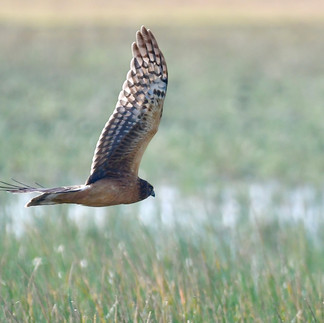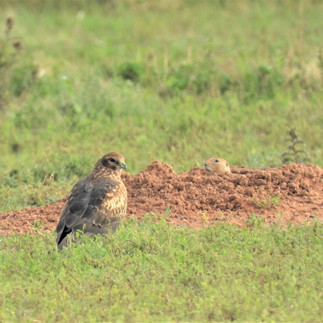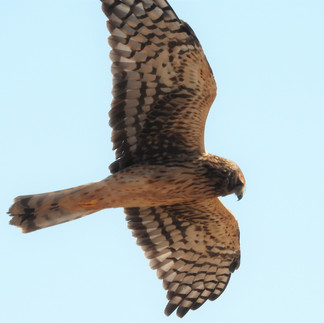Northern Harriers Silently Glide over Panhandle Countryside
- Vicki Wilmarth

- Oct 13, 2021
- 2 min read

Northern Harriers soar over the agricultural fields of the Texas Panhandle all year, but they are particularly populous in our area between October and April, generally going further north to breed. When they return in greater numbers in the fall, you can frequently see them flying low to the ground, seemingly bouyant, as if floating on ocean waves. Harriers prey from the sky on rodents and small birds, and then after their meal, quickly return to their aerial search pattern above the grass.

The most noticeable feature of Harriers is the white rump. That bright tail base can be easily spotted even if you are just driving by and happen to see a bird soaring over a field. Unfortunately for photographers like me, many times that white rump is all I get in a picture, because Harriers seem to always fly away from people.
While that white rump is the most visible field mark, to me the most fascinating thing about Harriers is their weird owl face. They don't have the normal intense, pointed face that we associate with Red-tailed Hawks, Cooper's or other hawks. Harriers, like owls, have a ring around their faces known as a facial disc. The stiff feathers in these facial discs direct sound towards the bird's ears. While gliding over a field, a Harrier can hear the faintest rustling of a field mouse or the quietest chirp of a bird, even if hidden deep in the tall grass.
Northern Harriers are also unique raptors because they are strongly sexually dimorphic, meaning it is easy to tell the adult males from the females, unlike most hawks. The female and juveniles have brown heads and bodies. The males are gray and white and are less populous than the females. In fact, the males are spotted so infrequently that they have earned the nickname, "the Gray Ghost". When exploring Texas Panhandle roads, I might see one gray male for every ten brown females/immature Harriers that I spot.


Like many raptors, the number of Northern Harriers is declining. Surveys indicate that the population is falling off by about .8% per year. Habitat loss, such as disappearing wetlands, collisions with structures, and, of course, human activity are all leading to fewer Harriers gliding over our local agricultural fields. Climate change is also playing a large role. For example, in Texas, drought has caused birds to abandon previous nesting sites, while El Ninos and La Ninas have pushed Harriers back and forth across the state looking for more favorable conditions.
But at least for now, any country drive in the Texas Panhandle between October and April should reveal at least a few Harriers gliding over the fields, searching for their next meal.




























Comments